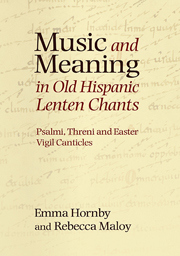Book contents
- Frontmatter
- Contents
- List of Music Examples
- List of Figures
- List of Tables
- Preface
- Abbreviations
- Manuscript Sigla
- Introduction
- CHAPTER 1 Thematic Congruity in the Old Hispanic Lenten Liturgies
- CHAPTER 2 The Threni
- CHAPTER 3 Melodic Language in the Old Hispanic Lenten Psalmi
- CHAPTER 4 Words and Music in the Psalmi
- 5 The Easter Vigil Canticles
- Afterword: Some Thoughts on the Relationship between the Old Hispanic Traditions A and B
- APPENDIX 1 A Guide to Reading Old Hispanic Notation
- APPENDIX 2 The Threni Texts
- Bibliography
- Index of Manuscripts Cited
- Index of Chants Cited
- Index of Scholars Cited
- General Index
- Studies in Medieval and Renaissance Music
5 - The Easter Vigil Canticles
Published online by Cambridge University Press: 05 December 2013
- Frontmatter
- Contents
- List of Music Examples
- List of Figures
- List of Tables
- Preface
- Abbreviations
- Manuscript Sigla
- Introduction
- CHAPTER 1 Thematic Congruity in the Old Hispanic Lenten Liturgies
- CHAPTER 2 The Threni
- CHAPTER 3 Melodic Language in the Old Hispanic Lenten Psalmi
- CHAPTER 4 Words and Music in the Psalmi
- 5 The Easter Vigil Canticles
- Afterword: Some Thoughts on the Relationship between the Old Hispanic Traditions A and B
- APPENDIX 1 A Guide to Reading Old Hispanic Notation
- APPENDIX 2 The Threni Texts
- Bibliography
- Index of Manuscripts Cited
- Index of Chants Cited
- Index of Scholars Cited
- General Index
- Studies in Medieval and Renaissance Music
Summary
The purpose of this chapter is to contextualize the Old Hispanic Easter Vigil canticles. Examining a wide range of sources for the early medieval Easter Vigil in the West allows us to better understand the differences between traditions A and B. In our analysis of the threni and psalmi we have identified parallels in texts, melodies and liturgical assignment between the Old Hispanic traditions A and B. Such similarities suggest either that the two traditions have a common origin or that there was interchange between the two practices in Toledo after the reconquest in 1085. The Easter Vigil canticles in the two traditions demand a different explanatory approach. Traditions A and B have partially different repertories of Easter Vigil canticles, arising out of their different selections of readings. Even the three canticles common to both traditions have different melodic forms, and, in one case (Cantemus), partially different text selections. These different readings cannot be understood as deriving from a common source. Further, the melodic treatments of the three shared canticles are strikingly different in the two traditions.
In this chapter we show that each tradition has different commonalities with other Western practices. To illustrate these connections we look more widely at Easter Vigil practices across Western Europe: repertoire, text origins, performance strategies, melodic style, and broader liturgical context. Initially, it might seem that one Old Hispanic tradition is a corruption of the other, or that each tradition has preserved some ancient elements while becoming decadent in others.
- Type
- Chapter
- Information
- Music and Meaning in Old Hispanic Lenten ChantsPsalmi, Threni and the Easter Vigil Canticles, pp. 244 - 302Publisher: Boydell & BrewerPrint publication year: 2013

